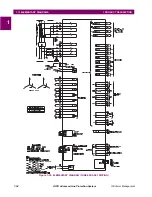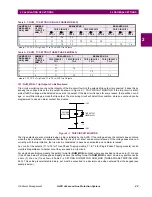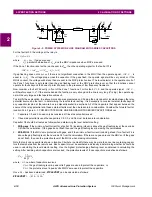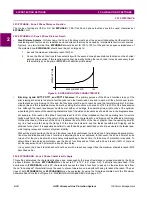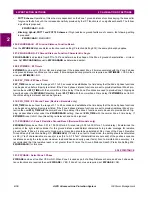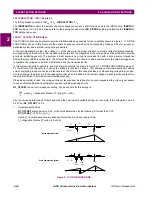
GE Power Management
ALPS Advanced Line Protection System
2-11
2 CALCULATION OF SETTINGS
2.3 PROTECTION SETTINGS
2
104: Z1GROUND - Zone 1 Ground Distance Functions
•
PUTT Scheme: The Zone 1 functions are required in the PUTT scheme to key the transmitter to insure tripping by the
remote terminal. The following setting must be used:
Z1GROUND = YES
•
Blocking, Hybrid, POTT1 and POTT2 Schemes: Set Z1GROUND equal to YES to use Zone 1 protection for ground
faults. Otherwise set Z1GROUND equal to NO. It is highly desirable to use Zone 1 protection in all schemes because it
provides independent, high speed direct tripping for all ground faults within the reach setting.
105: Z1GRDREACH - Zone 1 Ground Reach Setting
•
Uncompensated Systems: If potential transformers (PTs) are used, use a reach setting that is no greater than 90% of
the positive sequence impedance of the line to be protected. If capacitor voltage transformers (CVTs) are used, refer to
Figure 2–2: ALLOWABLE ZONE 1 REACH (WHEN USED WITH CVTs) on page 2–9 to determine if additional reduc-
tion of the Zone1 reach is required.
If single phase tripping is employed, and if the application involves a parallel line (bussed at both ends) where single
phase tripping is also employed, the Zone 1 ground distance functions should not be set greater than 80% of the line
impedance or greater than 80% of the setting determined using the ALLOW ZONE 1 REACH figure.
•
Compensated Systems: If series compensation is included in the protected line or in lines adjacent to the protected
line, the Zone 1 settings need to be modified. If the Z1GLEVDET setting is required, then Z1GRDREACH should be
set to 100% of the positive-sequence impedance of the line to be protected. If it is determined that the Z1GLEVDET
setting is not required, then Z1GRDREACH should be set as for an uncompensated system.
106: Z1GRDCHAR - Zone 1 Ground Characteristic
Z1GRDCHAR can be set to either MHO, REACT or QUAD. This setting determines the type of measuring unit used for the
Zone 1 ground distance functions, either a Mho function, a Reactance function, or a Quadrilateral function. Except for very
short lines, it is recommended that the Mho function be used, since its operating time is slightly faster than that of the Reac-
tance or Quadrilateral function. A “very short line” is one where the positive sequence source impedance (equivalent
source impedance behind the relay location) divided by the positive sequence impedance of the protected line is greater
than 5. Note that the value of 5 is a suggested boundary value, not an absolute cutoff, and that a reactance function can be
selected for a long line if desired.
107: Z1SUREACH - Mho Supervision of Ground Reactance Function
This setting is relevant only when the Zone 1 ground distance functions have been set to be reactance functions (see 106:
Z1GRDCHAR above). Since the reactance function is nondirectional, it must be supervised by a Mho function, as shown in
Figure 2–5: MAXIMUM ALLOWABLE REACH on page 2–13. This supervision is automatically implemented whenever the
reactance function is selected via the Z1GRDCHAR setting described above.
Z1SUREACH sets the
minimum reach that can be made on the supervising Mho function. This setting is easily calculated
if the maximum load flow across the line is known. The criterion used for establishing the minimum reach is based on main-
taining a 40° angular margin between angles A and B as shown in Figure 2–5: MAXIMUM ALLOWABLE REACH on page
2–13. Angle B is the “constant chord” angle of the characteristic, where the minimum reach is the chord. Since the super-
vising Mho unit has a circular characteristic, angle B is 90°.
The ALPS uses an adaptive feature to adjust the reach of the supervising Mho function as the load flow changes. The
reach can never be less than Z1SUREACH, but it can be larger. As the load flow decreases, the load impedance becomes
larger, and the reach is increased while maintaining the 40° difference between angles A and B. If the load now increases,
the reach will be decreased but will never be made less than Z1SUREACH. This adaptive feature allows the reactance
function to provide the maximum possible coverage for ground fault impedance.
108: Z1GROUNDK0 - Z1GROUND Zero Sequence Compensation Factor
Z1GROUNDK0 determines the amount of zero-sequence current used in the Zone 1 ground-distance functions to provide
“self-compensation.” This permits the reach setting to be based on the positive-sequence impedance to a ground fault. It
should be set to the following:
Z1GROUNDK0 =
where:
= zero-sequence impedance of line and
= positive sequence impedance of line
0.95
Z
0
L
Z
1
L
⁄
(
)
×
Z
0
L
Z
1
L
Содержание ALPS
Страница 2: ......
Страница 4: ......
Страница 182: ...5 20 ALPS Advanced Line Protection System GE Power Management 5 5 MOB TESTING 5 FUNCTIONAL TESTS FACTORY SETTINGS 5 ...
Страница 200: ...6 18 ALPS Advanced Line Protection System GE Power Management 6 5 ZONE REACH TESTS 6 FUNCTIONAL TESTS USER SETTINGS 6 ...
Страница 346: ...D 4 ALPS Advanced Line Protection System GE Power Management D 1 KEYPAD MENUS APPENDIXD D ...
Страница 352: ...F 2 ALPS Advanced Line Protection System GE Power Management F 1 WARRANTY INFORMATION APPENDIXF F ...
Страница 366: ...xiv ALPS Advanced Line Protection System GE Power Management INDEX INDEX ...




